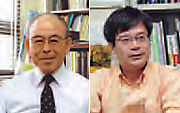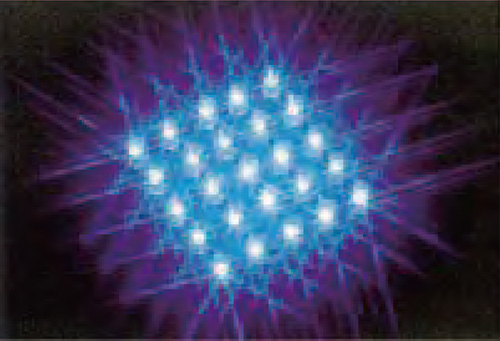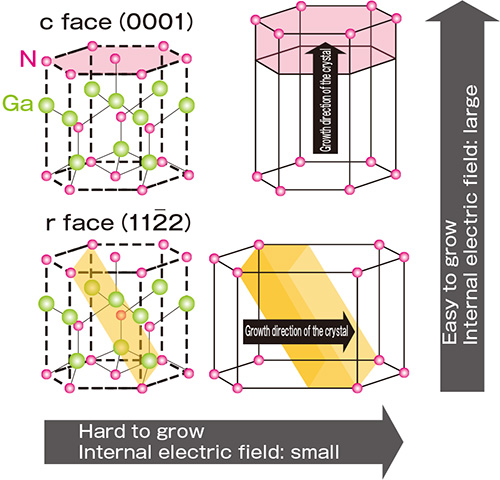Research Results
Meeting the challenge of "impossible" technology
Succeeded in the practical implementation of blue light-emitting diode! FY2016
Research in the unattainable territory that won the Nobel Prize
The 2014 Nobel Physics Prize was presented to three researchers, Professor Isamu Akasaki, Professor Hiroshi Amano and Professor Shuji Nakamura for the invention of an efficient blue light-emitting diode (LED). Red LEDs and yellow-green LEDs were developed in the 1960s; however, practical implementation of blue LEDs was so difficult that it was even said that "it would be impossible to realize blue LEDs by the end of the 20th century." Amid such a circumstance, Professor Akasaki, Professor Amano and Professor Nakamura worked on the high-quality single crystallization and the p-type doping of gallium nitride (GaN), both of which had been given up by researchers around the world. Their efforts from the 1980s to the 1990s finally led to their success in the development and practical implementation of blue LED. The development of blue LED resulted in the commercialization of much brighter and energy-saving white light, thus contributing to energy conservation in the world and an improvement of people's lives in areas without sufficient electricity. In addition to their use as light sources, blue LEDs are now being widely applied in various fields such as information technology, transportation, medicine and agriculture. Additionally, the technology to put gallium nitride into practical implementation developed by the three researchers is expected to find various applications in the future, such as an application in power devices that serve as electric power converters in electric vehicles and smart grids, next-generation power distribution grids,.

- Isamu Akasaki (Professor at Meijo University, Professor Emeritus and Distinguished Professor at Nagoya University) / Toyoda Gosei Co., Ltd
- Development of Creative Technology Seeds, Contract Development
- "Manufacturing technology of GaN blue light emitting diodes" Representative Researcher / Developing and implementing company (1987-1990)
- Hiroshi Amano (Professor at Nagoya University) / EL-Seed Corp.
- Development of Creative Technology Seeds, Contract Development
- "Manufacturing technology for LED moth-eye structure" Representative Researcher / Developing and implementing company (2007-2010)
Commercialization of blue LEDs through by using the contract development
Many researchers withdrew from the development of blue LED one after another concluding that its realization was impossible, however, Professor Isamu Akasaki saw the possibility of its realization in gallium nitride. In 1986, Professor Akasaki used the MOVPE method (metal organic vapor phase epitaxy method) for the formation of a buffer layer such as aluminum nitride (AlN) deposited in low temperature. As a result, the layer filled the differences such as the lattice constant between a sapphire substrate and a gallium nitride. This attempt led to the creation of a high-quality single crystal of gallium nitride.
In 1987, Toyoda Gosei Co., Ltd. and Professor Akasaki decided to work together toward practical implementation of blue LEDs by utilizing the contract development provided from the Research Development Corporation of Japan (current JST). Finally, Professor Akasaki succeeded in the formulation of a p-n junction in gallium nitride, thus realizing the blue LED using gallium nitride for the first time in the world.
After this project was successful, the blue LEDs was commercialized. JST supported the company by providing a development cost of 550 million yen, and this business brought about an income of about 5.6 billion yen as license fee (as of 2013). Company's enthusiasm and an effective support system, combined with outstanding technology, made the impossible possible.
LED development continues to the next generation
Hiroshi Amano was once a student of Professor Akasaki and was also involved in his blue LED research. Professor Amano is presently advancing his own LED research with the aim of improving the efficiency of LED.
He is now making special efforts to enhance LED light efficiency, which is currently about 50%, to as close to 100% as possible and to develop a new yellow LED, thus spending every single day for the aim of developing the ultimate light source that humanity could possibly create. EL-Seed Corp. is a venture corporation that was established in 2006 by JST's Supporting Program for Creating University-Initiated Ventures"Monolithic High- Output Color Rendered Large White LED Development." Mr. Satoshi Kamiyama, Chief Scientific Officer of the company, also used to learn from Professor Akasaki at his laboratory, being two years junior to Professor Amano. Based on Professor Amano's research results, Mr. Kamiyama succeeded in the contract development "Manufacturing technology for LED moth-eye structure", that can greatly enhance the light output of LEDs.
The LED research that started with Professor Akasaki will continue to be taken over by young researchers and produce great results.

Blue light-emitting diode

- Shuji Nakamura (Professor at the University of California, Santa Barbara)
- ERATO
- "NAMAMURA Inhomogeneous Crystal project" Reserch Director (2001-2006)
Further progress in the development of gallium nitride-based devices
After bright blue LEDs were put into practical use in 1993, further research and development aiming efficient and cost reducing technology were started For this goal, the ERATO"NAMAMURA Inhomogeneous Crystal project" had started and detailed research was conducted. The research group focused on"inhomogeneity," a special property of a nitride semiconductor, and attempted to improve the performance of devices by intentionally utilizing this property.
Indium gallium nitride ( InGaN) used in the light- emitting layer of the conventional blue LED allows a minute electric field to be generated inside because of its structure, which was found to lead to a decrease in luminance efficiency. The realization of a blue LED with the luminous efficiency higher than that of conventional ones and a bluish-purple laser diode was achieved by making crystals grow toward the direction in which the generation of a minute electric field is less likely to occur. Additionally, utilizing an ammonothermal method, in which ammonia is used to produce crystals, opened the door to the bulk production of gallium nitride single crystals. At the same time, this project promoted the understanding of gallium nitride-based materials as the solid state physics through revealing the light-emitting mechanism of a gallium nitride blue LED, providing new guidelines for the designing of various semiconductor devices.

Crystals tend to grow toward the face c (faces in pink), which allows an electric field to be generated inside. Therefore, the research group focused on the face r (faces in orange), in which electric field generated inside is small.
